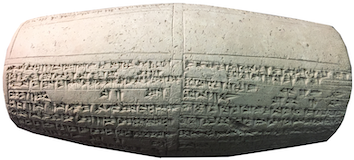Eula (temple of Gula as Ninkarrak at Sippar)

Eula is a minor temple at Sippar dedicated to the healing goddess Ninkarrak (Gula). The Neo-Babylonian ruler Nebuchadnezzar II (r. 604–562 BC) records that it had laid in ruins for a very long time before he had it build anew.
Names and Spellings
The Sumerian ceremonial name of this temple at Sippar means "House of Rejoicing."
- Written Forms: e₂-ul-la.
Known Builders
- Neo-Babylonian (ca. 625–539 BC)
- Nebuchadnezzar II (r. 604–562 BC)
Building History
Several Akkadian inscriptions of Nebuchadnezzar II, the son and immediate successor of Nabopolassar (r. 625–605 BC), record that this Neo-Babylonian king had Eula rebuilt anew because it had been in ruins for such a long time that its ground plan could only be recognized after his workmen carefully examined its site and discovered an inscribed clay dog figurine buried near its foundations. Texts written on two- and three-column clay cylinders from Sippar, record some of the details. One text records the following:

BM 091100a two-column clay cylinder with an Akkadian inscription of the Neo-Babylonian king Nebuchadnezzar II recording his rebuilding of the Eula temple at Sippar. Photo credit: Frauke Weiershäuser.
Presumably, after relaying the foundations on their original positions, Nebuchadnezzar's workmen built the temple's brick superstructure anew, roofed it, and decorated its interior. Those building stages are not recorded in presently-known inscriptions.
Archaeological Remains
Eula has not yet been identified in the archaeological record. Nebuchadnezzar II's inscriptions give the impression that the temple was an independent, freestanding structure, rather than a (complex of) rooms in Ebabbar. Because the temple has not yet been discover, this cannot yet be confirmed with any degree of certainty.
Further Reading
- George, A.R. 1993. House Most High: The Temples of Ancient Mesopotamia (Mesopotamian Civilizations 5), Winona Lake, p. 155 no. 1167.
Banner image: satellite image of Sipper (left); plan of Ebabbar and Ekunankuga (center); and photo from the excavations of the library at Sippar in March 1989 (right). Plan adapted from L. De Meyer Tell ed-Dēr 3: Sounding at Abū Ḥabbah (Sippar), plan B. Excavation photograph by Jean-Luc Manaud/Gamma-Rapho via Getty Images.
Jamie Novotny & Joshua Meynell
Jamie Novotny & Joshua Meynell, 'Eula (temple of Gula as Ninkarrak at Sippar)', Babylonian Temples and Monumental Architecture online (BTMAo), The BTMAo Project, a sub-project of MOCCI, [http://oracc.org/btmao/Sippar/Eula/]